This week's post will finish off my examination of the 5d value from this set, with an examination of the perforations and the re-entries and plate flaws found on this stamp.
Plate Flaws and Re-Entries
Ince and Osborne in their May 1976 West Africa Study Circle Bulletin, note 6 plate flaws and re-entries. Four are confined to specific positions in the sheet, while one is present on every stamp and two are found on many, but not all stamps.
All stamps show some doubling of the top inner vertical frameline at the left of the design. On positions 9, 11, 13, 18, 19, 20, 21, 25, 27, 28, 29, 33, 34, 43, and 45, the inner frameline on the left hand side, near the top is doubled, especially near the centre opposite the "P" of "Protectorate". In addition the background shading tends to overlap the frameline.
The varieties that are specific to one position on the sheet are as follows:
- Position 6 - There is a spot of colour on the outer frameline to the left of the foot of the "N" of "Niger".
- Position 8 - There are spots of colour on the outer frameline to the right of the foot of "T" of "Coast", and on the right hand frameline. The stem of the "T" tends to taper at the top.
- Position 19 - There is a hairline from the crossbar in the "A" of "Coast" down to the inner frameline.
- Position 41 - The inner vertical frameline on the right hand side intersects the background shading in the upper half. There is also often doubling of this line.
Interestingly, in my study of the examples in my stock I did not manage to find a single example of positions 6, 8 and 19. However, I did find a few unlisted varieties, which I will illustrate here. But first, I want to show the varieties described above that I do have examples of.
The first of these is the position 41 re-entry:

This picture clearly shows the horizontal lines extending out slightly beyond the frameline. In addition, the portion of the vertical frameline in this area which intersects these shading lines is doubled.
There is some variability in the strength of the doubling. I have another example which shows stronger doubling, that extends into the flower ornaments and the outer frameline:
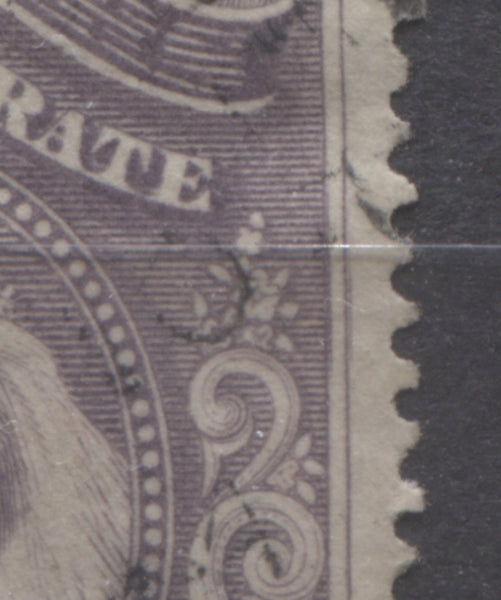
Unfortunately the doubling on the flowers does not show up clearly in this scan. It is mainly the left side of the main flower, and is relatively strong, but I suspect it is too small a detail for the scanner to pick up at 1200 dpi.
The next varieties I want to illustrate are the doubling of the upper left corner, that is found on all stamps and the inner left vertical frameline opposite the "P" of "Protectorate". The scan below shows the upper left corner of a slate stamp:
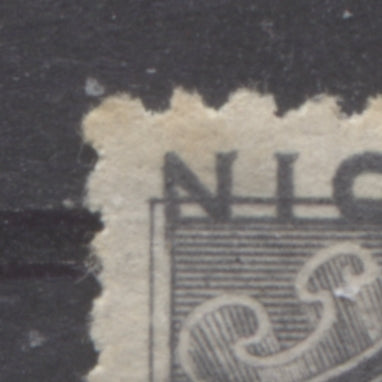
Here we can see the doubling of the inner vertical frameline just below the "N" of "Niger". This is present to greater or lesser extent on every stamp in the sheet.
The scan below shows three different examples of doubling typically found on the left side of the stamp, with those positions identified above. Each differs slightly:
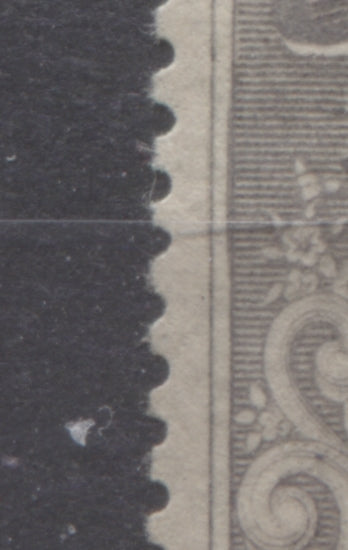
Here, you can see clear doubling of the inner frameline and just the faintest trace of doubling of the outer frameline.
Here is another example:
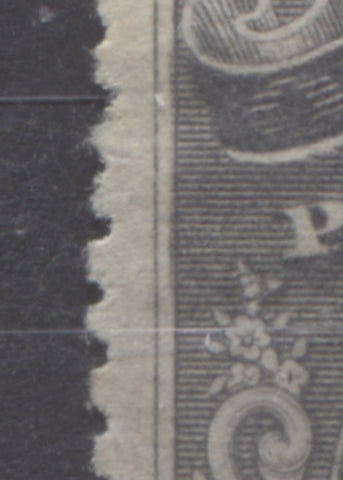
Here, the doubling is clearer and you can see clear extension of the horizontal shading lines into the space between the framelines. Also, and this isn't documented by Ince and Osborne, the doubling occurs opposite the ribbon containing the obliterated "Oil Rivers" inscription.
Finally, I have a third example:
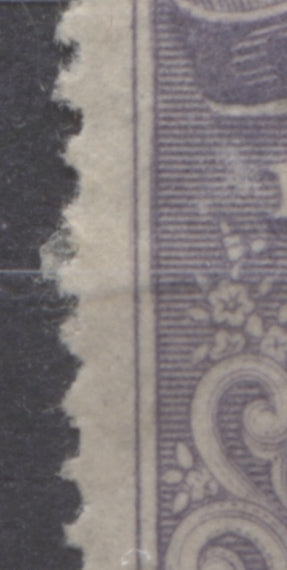
In this example the doubled area is longer and you can clearly see doubling of both the inner and outer frameline, though the doubling of the outer frameline is much fainter. Again, some doubling opposite the ribbon is also visible.
In addition, there are two varieties I have found, which are not mentioned by Ince and Osborne. The first is a very fine horizontal hairline joining the "S" and "T" of "Coast". This is too faint to show up on the scans, so I cannot illustrate it here. But it is very clear. The second variety is a horizontal line that crosses the scroll just above the left value tablet:
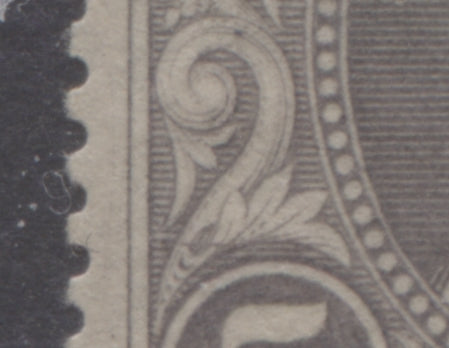
If you look at the portion of the scroll just above the "5", you can see a clear horizontal line through the leftmost leaf and lower part of the scroll.
Perforations
Gibbons lists only three perforations for this stamp, being 14.5-15, 13.5-14 and 13.5-14 compound with 12-13. The compound perforation is the scarcest of course, and is valued at over three times the price of the other two perforations. The most common according to Gibbons is 13.5-14.
In my study of these stamps, I have found the following perforations:
- 15.1 x 15
- 14 x 14 x 13.75 x 14
- 14.1 x 14.25 x 14.2 x 14.1
- 14.9 x 14.75 x 14.6 x 14.75
- 15
- 15 x 15.1
- 14.1 x 14 x 14 x 14.1
- 15 x 14.6 x 15.1 x 14.6
- 14.9 x 15 x 14.8 x 14.9
- 14.5 x 13.8 x 14.5 x 13.9
- 14 x 14.3;13.1 x 14.2 x 14.2
- 15 x 15.1 x 14.9 x 15
- 14.8 x 15 x 14.75 x 15
- 14.1 x 13.75
- 14
- 15.1
- 14.5 x 13.9
- 13.9 x 14.1
- 14.3 x 14.3 x 14.1 x 14.2
- 14.1 x 14 x 14.2 x 14
- 15 x 14.6 x 14.8 x 14.5
- 15 x 15 x 15 x 15.1
- 13.9 x 13.9 x 14.1 x 13.9
- 14.1
- 14.5 x 14.2 x 14 x x 14.1
- 15 x 14.8
- 14.1 x 14 x 14 x 14.1
- 14 x 14.1
- 14.1 x 14.1 x 14.2 x x 13.9
- 14.5 x 14 x 14.25 x 13.9
- 14.1 x 14
- 14 x 14.1 x 13.8 x 14
- 14 x 13.8;14.65 x 14 x 13.8;14.3
- 14 x 14.3 x 14.1 x 14.2
- 14 x 14.25;14.75 x 13.9 x 14.2
- 14 x 13.9
- 14.9 x 14.5 x 14.75 x 14.5
- 14.5 x 14.6
- 15 x 15 x 15 x 14.9
In all I have found 39 different perforations across 74 mint and used examples, which includes 1 pair. In most cases, I have only one example of each, but there are some cases where I have more than 3:
- Perf. 15.1
- Perf. 15
- Perf. 15 x 15.1
- Perf. 14
In addition to this, the lowest perforation measurement I have found is 13.1, which appears in the sole example of the compound perforation marked in red. This is the compound perforation listed in Gibbons as "13.5-14 comp 12-13". However, after this, the next lowest measurement is 13.75. I have not seen any measurements between 13.5 and 13.7 on any of the stamps. So, I believe that it is more accurate to say that the perforations are generally all variations of 15, 14, or 14.5. I would expect that each perforation would have a variation of 0.2 on each side of the measurement, so that the perforations could be grouped as follows:
- 14 comp 14.5;13.
- 14.8-15.2
- 14.3-14.7
- 13.75-14.2
- 14.8-15.2 x 14.3-14.7
Using these groupings, we can assign each a colour and assign the above perforation measurements to each one. Let us assume that the 14 comp 14.5;13 is still dark red, 14.8-15.2 group is plain text, 14.3-14.7 is bold black, 13.8-14.2 is green, 14.8-15.2 x 14.3-14.7 is orange and 13.75-14.2 x 14.3-14.7 is mauve. Using these colours I have coded the perforations list as follows:
- 15.1 x 15
- 14 x 14 x 13.75 x 14
- 14.1 x 14.25 x 14.2 x 14.1
- 14.9 x 14.75 x 14.6 x 14.75
- 15
- 15 x 15.1
- 14.1 x 14 x 14 x 14.1
- 15 x 14.6 x 15.1 x 14.6
- 14.9 x 15 x 14.8 x 14.9
- 14.5 x 13.8 x 14.5 x 13.9
- 14 x 14.3;13.1 x 14.2 x 14.2
- 15 x 15.1 x 14.9 x 15
- 14.8 x 15 x 14.75 x 15
- 14.1 x 13.75
- 14
- 15.1
- 14.5 x 13.9
- 13.9 x 14.1
- 14.3 x 14.3 x 14.1 x 14.2
- 14.1 x 14 x 14.2 x 14
- 15 x 14.6 x 14.8 x 14.5
- 15 x 15 x 15 x 15.1
- 13.9 x 13.9 x 14.1 x 13.9
- 14.1
- 14.5 x 14.2 x 14 x 14.1
- 15 x 14.8
- 14.1 x 14 x 14 x 14.1
- 14 x 14.1
- 14.1 x 14.1 x 14.2 x x 13.9
- 14.5 x 14 x 14.25 x 13.9
- 14.1 x 14
- 14 x 14.1 x 13.8 x 14
- 14 x 13.8;14.65 x 14 x 13.8;14.3
- 14 x 14.3 x 14.1 x 14.2
- 14 x 14.25;14.75 x 13.9 x 14.2
- 14 x 13.9
- 14.9 x 14.5 x 14.75 x 14.5
- 14.5 x 14.6
- 15 x 15 x 15 x 14.9
This yields some interesting results. Out of the 39 different perforation varieties:
- 10 are variations of perf. 14.8-15.2 and include many of the more common measurements, so that this group comprises the single largest out of the 74 stamps that I examined.
- 1 is the scarce 13.75-14.2 compound with 13.2 perforation, being only 1 single stamp of the 74 that were examined. Clearly it is vastly undervalued in Gibbons as it is much, much more than three times as scarce as the more common perforation measurements.
- 1 is a variation of 14.3-14.7, which would also seem to be a scarce perforation.
- 15 are variations of 13.75-14.2, although most of these are just 1 or 2 stamps
- 4 are compounds of 14.8-15.2 and 14.3-14.7, and in each case there is generally only 1 mint or used example.
- 8 are compounds of 13.75-14.2 and 14.3-14.7, and again there is generally only 1 mint or used example.
This is, I think a more accurate picture of the perforations on this stamp: 3 basic measurements, with three scarcer compound perforations. The two common perforations being 14.8-15.2 and 13.75-14.2 would appear to be more or less the same scarcity, and the Gibbons prices reflect this. But because of the way in which Gibbons has defined the perforation groupings, the scarcer compound perforations, except for the 13.2 compound, have essentially been obscured.
This concludes my study of the 5d value. The last value of the series is the 1/- black, which I will cover next week. Then it will be time to look at the postal history before moving on to the second unwatermarked issue.

